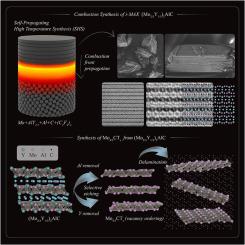Rapid and scalable combustion synthesis of (Mo2/3Y1/3)2AlC i-MAX as the precursor for vacancy-ordered MXene
IF 14.3
1区 材料科学
Q1 MATERIALS SCIENCE, MULTIDISCIPLINARY
引用次数: 0
Abstract
For MXenes to be viable in commercial and industrial applications, their production must rely on processes that are energy-efficient, environmentally sustainable, and scalable. A critical factor influencing this viability is the synthesis route of the parent MAX phase. In this study, we report a novel and rapid approach for synthesizing a chemically ordered MAX phase (i-MAX), specifically the in-plane ordered (Mo2/3Y1/3)2AlC, using self-propagating high-temperature synthesis (SHS) completed in one minute. The target MAX phase yield was estimated using Rietveld refinement to be 73.6% with the main impurity phases identified as Mo3Al2C and YF3. Thermodynamic calculations combined with experimental characterizations indicate that the use of an aluminum–yttrium master alloy played a pivotal role in achieving high synthesis yield by facilitating a sequence of intermediate phase transformations that enhance reaction kinetics and i-MAX formation. This method involves the utilization of Poly(tetrafluoroethylene)—(C2F4)n as a promoter, which enables the formation of volatile fluorides or fluorine-containing intermediates, making the reaction self-sustaining. Etching and delamination of the SHS-produced i-MAX phase yielded a vacancy-ordered MXene with the formula Mo4/3CTx, with a yield value twice that obtained using the conventional MAX-phase parent material preparation route. This work demonstrates the method’s effectiveness in achieving rapid, straightforward, and energy-efficient synthesis of a diverse range of MAX and i-MAX phases, thereby paving the way for scalable and efficient MXene production.

(Mo2/3Y1/3)2AlC i-MAX作为空位有序MXene前驱体的快速可扩展燃烧合成
为了使MXenes在商业和工业应用中可行,它们的生产必须依赖于节能、环境可持续和可扩展的工艺。影响这种活力的关键因素是母体MAX相的合成途径。在这项研究中,我们报告了一种新的和快速的方法来合成化学有序的MAX相(i-MAX),特别是平面内有序(Mo2/3Y1/3)2AlC,使用自传播高温合成(SHS)在一分钟内完成。采用Rietveld细化法估计MAX相产率为73.6%,主要杂质相为Mo3Al2C和YF3。热力学计算结合实验表征表明,铝钇中间合金的使用在实现高合成收率方面发挥了关键作用,通过促进一系列中间相转变,提高反应动力学和i-MAX的形成。该方法利用聚(四氟乙烯)- (C2F4)n作为促进剂,使挥发性氟化物或含氟中间体形成,使反应自我维持。对shs制备的i-MAX相进行蚀刻和分层,得到了分子式为Mo4/3CTx的空位有序MXene,其屈服值是传统max相母材制备工艺的两倍。这项工作证明了该方法在实现各种MAX和i-MAX相的快速、直接和节能合成方面的有效性,从而为可扩展和高效的MXene生产铺平了道路。
本文章由计算机程序翻译,如有差异,请以英文原文为准。
求助全文
约1分钟内获得全文
求助全文
来源期刊

Journal of Materials Science & Technology
工程技术-材料科学:综合
CiteScore
20.00
自引率
11.00%
发文量
995
审稿时长
13 days
期刊介绍:
Journal of Materials Science & Technology strives to promote global collaboration in the field of materials science and technology. It primarily publishes original research papers, invited review articles, letters, research notes, and summaries of scientific achievements. The journal covers a wide range of materials science and technology topics, including metallic materials, inorganic nonmetallic materials, and composite materials.
 求助内容:
求助内容: 应助结果提醒方式:
应助结果提醒方式:


